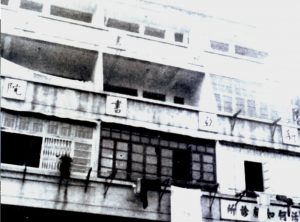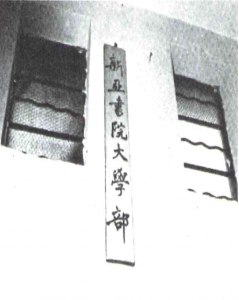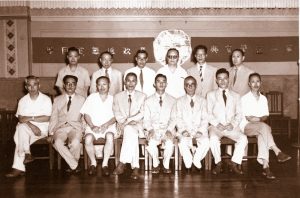New Asia College was founded in 1949 at a time of extreme adversity by Mr. Ch’ien Mu and other scholars from mainland China. Their objective was to establish an educational institution which integrated the scholarly spirit of the Song and Ming academies and the tutorial system of western universities. With humanity as its basis, the College also aimed to facilitate cultural exchanges between East and West, and to advocate for peace and the well-being of the human race.
 |
 |
 |
1949:
The Asia Evening College of Arts and Commerce was established in October by Mr. Ch’ien Mu and other scholars who emigrated from mainland China. Three classrooms were rented for evening classes at Wah Nam Middle School in Wai Ching Street in Kowloon, offering courses like “General History of China” taught by Mr. Ch’ien Mu, “Introduction to Philosophy” by Mr. Tang Chun-i, “Economics” by Mr. Tchang Pi-kai, and “Politics” by Mr. Tsui Shu-chin. Apart from the classrooms in Wai Ching Street, another flat in Battery Street was rented as a hostel.
1950:
With the generous assistance from Mr. Wang Yueh-feng, the College managed to register as a day school with the Education Department. It was restructured, and changed its name to New Asia College. Mr. Ch’ien acted as the College President, with Mr. Tang Chun-i as Registrar, and Mr. Tchang Pi-kai as Comptroller. The second and third floors of Nos. 61, 63, 65, Kweilin Street in Sham Shui Po were rented as the school premise. At its onset, it had six departments, namely Economics, Business, Agriculture, Language and History, Philosophy and Education, and Journalism and Sociology. In its early years, New Asia College was blessed with a teaching team of renowned scholars, including Mr. Ou Tsuin-chen, former Secretary of Higher Education for the Ministry of Education of the Republic of China and student of the famous American philosopher and educator John Dewey; Mr. Yang Ju-mei, who was a household name in Chinese financial circles; calligrapher Tseng K’o-tuan; historian Tso Shun-sheng; oracle bone expert Tung Tso-pin; litterateur Hsia Tsi-an; sinologists Jao Tsung-i and Lo Hsiang-lin. The teachers were offered only a modest salary, equivalent to that of a level-2 teacher in a Hong Kong Government primary school.
Most of the students had fled from the Mainland, and could not afford the tuition fees. Some students were offered a little subsidy, and board and lodging for caretaking work. The New Asia Spirit “Starved is my flesh, Forged is my soul” was laid down in the College Anthem back in those days, and was fully reflected in the efforts of the students and teachers at that time.
In addition to regular courses, the College also hosted public cultural seminars on Sunday evenings. More than 155 seminars were held in four to five years, all of which were free-of-charge and fully attended by enthusiastic audiences. The seminars featured, in addition to the three College founders, a number of prominent professors as speakers, such as Tung Tso-pin, Hsia Tsi-an, Tso Shun-sheng, Frederick Sequier Drake, Jao Tsung-i, and many visiting scholars from the West. It was through these seminars that the College of modest beginnings gradually acquired its reputation and prestige.
1950 – 53:
This was the most difficult period of the College. Mr. Wang Yueh-feng’s business suffered tremendous losses, and he could no longer support the College. It posed a dire financial challenge to it, as tuition fees occupied only 20% of the budget. To raise funds, Mr. Ch’ien went to Taiwan while the teachers agreed to salary suspension. In the winter of 1950, Mr. Ch’ien met with Mr. Chiang Kai-shek, then President of the Republic of China, in Taipei, and the latter promised to donate a monthly stipend of HK$3,000 to the College from the operating budget of his presidential office. Mr. Tchang and Mr. Tang frequently wrote in local newspapers, and donated their royalty payments. The former even pawned his wife’s jewelry to help with the College’s finances.
1952:
The New Asia Board of Governors was incorporated, with Mr. Vermier Y. Chiu, a barrister, as the Chairman and Legal Advisor. In the same year, the Hong Kong Government stipulated that all private schools must register as a “limited company” with the Commerce and Industry Department. However, all the College staff objected to business registration, as they considered that the College’s goal was education, not financial gain. Mr. Chiu fought for exemption and succeeded after a year of negotiations with the Government — the College was duly recognized as an educational enterprise and a nonprofit private school.
1953:
The Yale-in-China Association sent Dr. Harry R. Rudin to Hong Kong as its representative. As he fervently embraced the College’s educational goals, the Yale-in-China Association and the College began their cooperation in 1954.
1953 – 54:
New Asia College set up the Institute of Advanced Chinese Studies in Prince Edward Road, and expanded its campus by renting another premise in Grampian Road in Kowloon City. Students then attended classes on the campuses of Grampian Road and Kweilin Street.
1954:
The Yale-China Association began its collaboration with New Asia College. In the meantime, the College received subsidies from the Asia Foundation, Harvard-Yenching Institute, the Rockefeller Foundation, and other organizations.